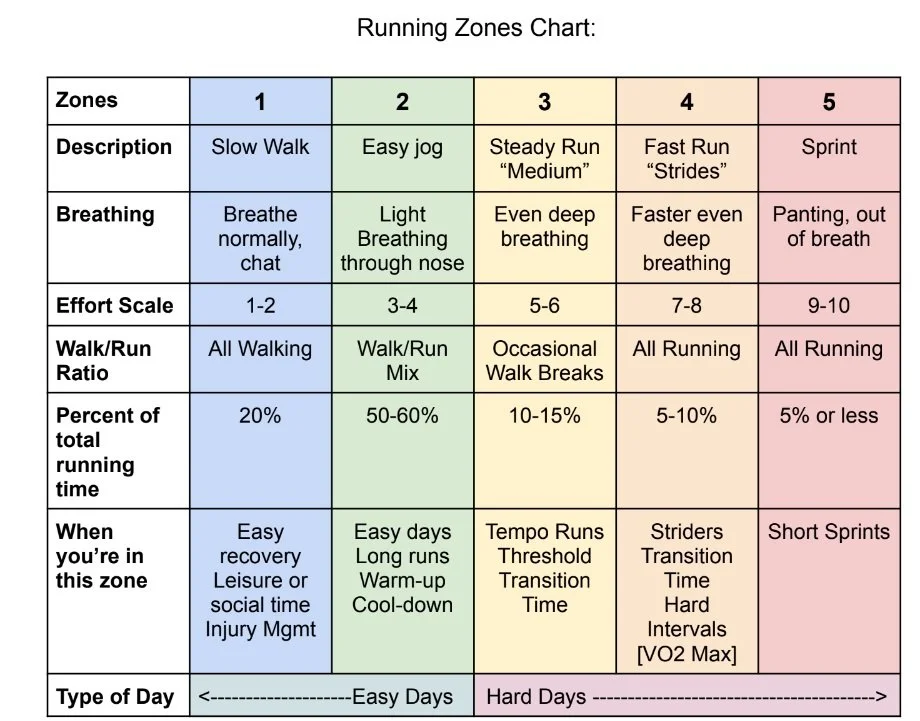
LEVEL 3: WEEK 1
Intervals, Hills & Intensity
REMINDER: $199 (then $75/month)
Take a minute to complete your onboarding.
THIS WEEK’S TO-DO LIST:
Complete Level 3 onboarding assignments
- Health and Well-Being Screening and Intake
- Structures, Supports and Community
- Reflection - Current fitness and mindsetCheck Final Surge for neighborhood run route
Connect with the Whatsapp group
Add date to the calendar for next week’s Coaching Call
Complete Week 1 assignments
Week 1 Challenge: Add strides to one of your easy runs, and share your results in the WhatsApp Group
ASSIGNMENT #1
Creating easy run days
Intensity: Easy versus hard!
The mistake many novice runners make: doing their easy runs too hard, and their hard runs too easy. They run everything at “Medium” intensity, which has two problems:
They don’t have enough recovery days, and eventually get injured.
It leads to stagnation and frustration when they hit a plateau and stop seeing improvement.
So what is an “Easy” run day?
Low Intensity
Able to talk comfortably
Able to breath easily through your nose
Never becoming winded or out of breath
Short duration: 20 minutes to an hour (depending on fitness level) and shorter than your average run
Modify for cross training (bike or swim can go longer duration)
Use the run/walk strategy (if you don’t know what this is, return to Level 1: Get Started)
Do a ratio you know is easy for you
It should feel easy! You should get to the end of this run and say, “Gee, I’m not sure if I got much out of that. It didn’t feel like I challenged myself.” PERFECT!
Trust that improvements are happening in your body that you can’t feel immediately, such as:
Increasing the efficiency of your running form
Growing new veins and capillaries to deliver oxygen to your muscle cells
Building a strong base of cardio endurance
Triggering your cells to make more mitochondria
Strengthening and lubricating ligaments, tendons and joints
Flushing muscles with blood and fluid, which removes toxins and speeds recovery
Boosting your mood by releasing endorphins
Improving your sleep in the short and long term
Helping your digestive process “move along” at a healthy pace
Running is NOT an instant gratification activity! Watch this video to learn how to strive for those easier runs on a daily basis:
ASSIGNMENT #2
Creating your running zones
What is a hard run day?
I have good news and day news to share with you. Let’s start with the bad….
The bad news is: running is a slow process of building fitness, strength, endurance and mental toughness over time. You may not see immediate results or feel amazing every time you run.
The good news is: running will improve the quality and length of your life by preventing disease, make you happier, sleep better, and make you more attractive (no guarantee on that last one, but it makes sense, right?)
So let’s talk about what a hard run day actually looks like:
High intensity
- Breathing hard, finding it difficult to talk
- Pushing yourself beyond where you usually would stop
- Feeling a dull aching in your musclesShort intense intervals
- Short bursts of faster running with rest time in between
- Ex: Running up a hill for 1 minute, walk back down for 3. Repeat 3 times
- Ex: Run hard for 400 meters, rest for 3 minutes. Repeat 4 times.Long duration
- Long, slow runs
- Using run/walk strategy
- Around 1/3 of your total weekly mileage, maxUsing run/walk strategy
- Reduce walk duration and increase run duration
- Use walks as breaks between hard efforts (hills, sprints, strides)
But the chart above is deceiving. Each column is the same size -- when you should NOT be spending the same time in each of these zones!
If we made the size of each zone approximately proportional to the amount of time you should be spending at that zone, here is what it would look like:
Looks sustainable, right? Lots of recovery time, easy running. Balances the hard days. Sign me up!
Now imagine if you were doing what most novice runners do — spending most of your time in the “Medium” zone:
Does that look sustainable to you!!? [If it looks insane, you are following this lesson perfectly]
*Note: the only thing this handy chart does not capture well is long runs. Your long duration runs should be in Zone 1-2, and they are considered a “hard” or “effort” day. They should be no more than once per week, probably once every two weeks at the beginning of your training.
The Bottom Line: MORE of your run days should be easy days than hard days. MOST of your run time should be slow or walking, in Zones 1 and 2.
ASSIGNMENT #3
Interval training
Why do interval training?
The Interval Training method is not only efficient but also highly effective in helping you achieve your running goals. With intense intervals, you'll be pushing your body to increase your heart rate and metabolism, leading to more calorie burn and improved aerobic fitness. Interval training is the key to getting faster, making all your running easier, and improving your overall running performance:
Be more efficient
- Interval running can give you more gains in less timeTo get faster
- Want to run fast? You gotta train fastTo make all running easier
- Improve VO2 max
- Grow more capillaries
- Make more mitochondria
- Make heart muscles stronger
Here is a great video to learn how to run fast and build interval training into your daily runs.
ASSIGNMENT #4
Types of runs
How to run faster and speed…
Steady-State Runs are the foundation of your training, consisting of Base Runs, Long Runs, Tempo Runs, and Recovery Runs, each serving a specific purpose in building your endurance and fitness. On the other hand, Interval-Type Runs introduce you to a world of speed and intensity, including Fartlek runs, Intervals, Hill Repeats, and more. These diverse workouts will challenge your body and enhance your running performance.
Steady-State Runs
- Base Run: These short to moderate-length runs will make up the bulk of your weekly training mileage
- Long Run: Pushing your maximum running distance or time; usually done slowly and sometimes called LSD - Long, Slow Distance
- Tempo Run: A steady run at a faster pace. Usually with a slower warm-up and cool-down
- Recovery Run: An easy walk/run to recover from a hard effort. Designed to get legs moving, increase circulation and range of motion.Interval-Type Runs
- Fartlek: I know, it sounds funny. This type of run has varying fast/slow intervals of different durations, usually mixing jogging with faster running. They can also be alternating walk/run
- Intervals: Any run where you alternate fast running with slow running or walking recovery
- Repeats - Doing a set distance multiple times, with rest in between (ex: 4 x 800m with 2 minutes rest -- or -- 2 x 12 mins with 800m walk rest)
- Progressions - An interval workout where the distance changes for each interval (ex: 400m, 800m, 1-mile, 2-mile with 1-lap walk rest in between)
- Ladders - Intervals that increase in distance, then decrease, or vice versa. (ex: 400m, 800m, 1600m, 800m, 400m with 3 minute jog rest in between)Hill Repeats
- Doing repeat intervals on a hill. Typically running hard up the hill, and walking or jogging back down for rest.
ASSIGNMENT #5
Strides and speedwork
What are strides?
Caution: High Injury Risk!
If you are just recovering from a strain, sprain, tendonitis, or stress fracture, I insist that you follow your doctor’s instructions, and I suggest that you hold off on speedwork until you’ve had no pain in the injured area for at least 2 weeks with light walking/running.
What are Strides? (Also called “Striders”):
Short, fast runs on a flat surface
Speed in Zone 4; not a sprint, but not slow
65-80% of your maximum speed
Should feel like floating or flying forward, without straining
Develop your “springiness” and naturally improve run form
Safe to do, unless you push too hard, or have existing injury
If you have never done strides before, here is a suggested progression to follow:
Ready for Week 2?
You’re nearly halfway to completion. Take your self-assessment and let’s reflect on your awesome achievement this week before moving on to the next week.
COURSE OUTLINE REMINDER
Level 3— Finding Your Stride (4 weeks)
Elevate your running prowess. Boost speed and endurance with intervals, conquer hills, master planning, and enhance performance with advanced strength exercises. Surpass your limits and achieve remarkable milestones in your running journey with Level 3.
WEEK 1
Intervals, Hills & Intensity
Incorporate interval training to improve speed and endurance, up and down.
WEEK 2
Mobility & Flexibility
Stay nimble and lengthen muscles for runner mobility.
COMPLETE
WEEK 4
Planning Your Training for Life
Learn how to structure your training and set achievable goals.
WEEK 3
Beyond the Basics
Learn specific exercises for each body part to stay health long-term.
In Level 3, you'll challenge yourself to new heights and push the boundaries of your running capabilities. By incorporating interval training, you'll boost your speed and endurance, allowing you to cover greater distances with ease. Conquering uphill and downhill running techniques will add variety and excitement to your workouts while improving your overall running form. You'll also learn the art of planning and goal setting, enabling you to structure your training effectively and achieve your desired outcomes. To enhance your running performance, Level 3 introduces more advanced strength exercises, ensuring your body is strong and resilient. Level 3 empowers you to surpass your limits, elevate your running prowess, and achieve new milestones in your running journey.











